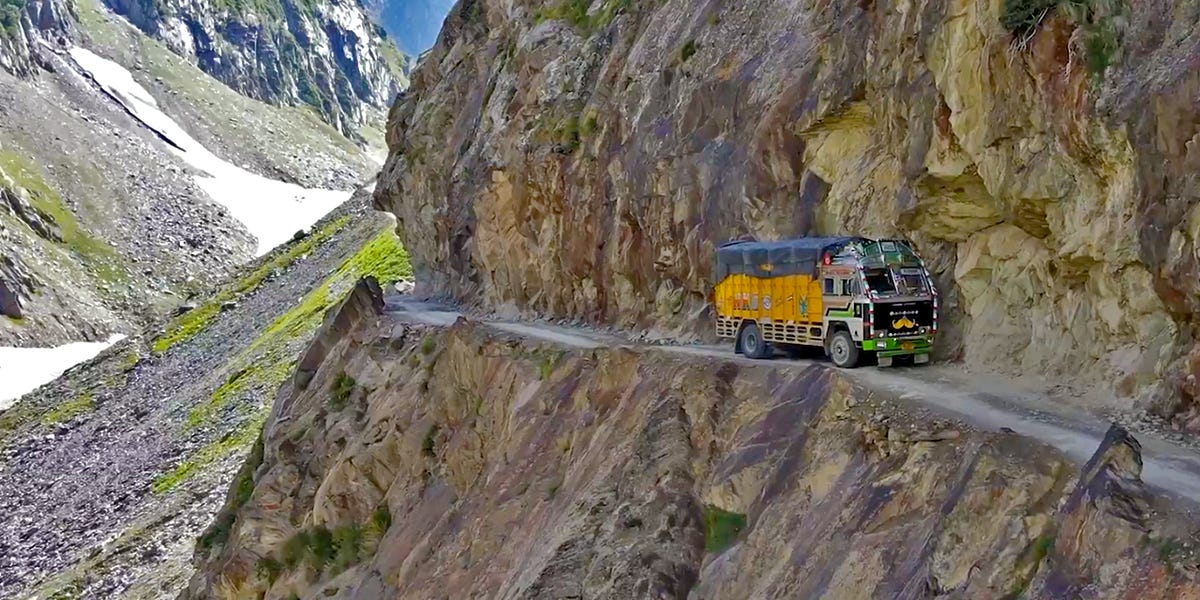Wheels of Courage: Surviving the World's Most Treacherous Trucking Route
Business
2025-04-13 15:30:02Content

In the rugged, mountainous terrain of Himachal Pradesh, a group of unsung heroes brave treacherous roads and extreme conditions to keep remote mountain villages connected with the outside world. These dedicated truck drivers navigate narrow, winding mountain passes, often risking their lives to deliver essential supplies to some of India's most isolated communities.
Their journey is far from easy. Steep cliff-side roads, unpredictable weather, and challenging landscapes test the limits of both driver and vehicle. Each trip is a delicate dance between skill and survival, where a single miscalculation could mean disaster. Despite the inherent dangers, these drivers remain committed to their critical mission of bringing food, medicine, and other vital resources to communities that would otherwise be cut off from the world.
The human cost of this essential service is profound. Many drivers face life-threatening risks daily, with accidents and harsh environmental conditions constantly threatening their safety. Yet they continue, driven by a sense of duty and the knowledge that entire communities depend on their successful delivery of supplies.
These truck drivers are more than transporters; they are lifelines, connecting remote mountain villages to the broader world and ensuring the survival of communities in some of India's most challenging geographical regions. Their courage and dedication represent the true spirit of service and human resilience.
Lifelines on Wheels: The Perilous Journey of Himalayan Truck Drivers
In the rugged, unforgiving terrain of Himachal Pradesh, a group of unsung heroes navigate treacherous mountain roads, bridging the gap between isolation and survival for remote mountain communities. These truck drivers are more than mere transporters; they are lifelines, risking everything to ensure essential supplies reach the most challenging and inaccessible regions of the Indian Himalayas.Courage Meets Challenge: Delivering Hope in the Highest Peaks
The Geographical Crucible of Extreme Logistics
The Himalayan landscape presents an unparalleled logistical nightmare that would intimidate even the most seasoned transportation professionals. Serpentine roads carved into near-vertical mountain slopes, with precipitous drops on one side and sheer rock faces on the other, create a gauntlet of challenges that test human endurance and vehicular resilience. These routes, often no wider than a single vehicle's width, demand extraordinary skill, unwavering concentration, and nerves of steel. Truck drivers in this region navigate through environments where nature's unpredictability is the only constant. Sudden landslides, rockfalls, and extreme weather conditions transform these routes into potential death traps. Monsoon seasons bring additional complexity, turning already treacherous paths into muddy, unstable surfaces that can give way without warning.Economic Lifelines of Mountain Communities
Beyond the physical challenges, these truck drivers represent the economic arteries of isolated mountain settlements. They transport not just goods, but hope, survival, and connection to the broader world. Essential supplies like food, medicine, construction materials, and agricultural inputs depend entirely on their ability to traverse these impossible routes. The economic impact of their work extends far beyond simple transportation. These drivers enable mountain communities to sustain themselves, supporting local economies and preventing complete isolation. Their trucks become mobile marketplaces, bringing necessary resources to regions where traditional infrastructure is virtually non-existent.Human Cost of Critical Infrastructure
The price of maintaining these critical supply lines is devastatingly high. Accident rates among Himalayan truck drivers are among the highest in the world, with fatalities occurring at an alarming frequency. Each journey represents a potential life-or-death scenario, where a momentary lapse in concentration or an unexpected natural event can result in catastrophic consequences. Professional drivers in this region undergo rigorous training that goes beyond standard driving skills. They must understand complex terrain dynamics, weather prediction, vehicle mechanics, and emergency response techniques. Many drivers develop an almost supernatural sense of road conditions, reading subtle environmental cues that might escape ordinary observation.Technological and Cultural Adaptation
Modern technology is gradually transforming this dangerous profession. Advanced GPS systems, satellite communication, and improved vehicle engineering are helping mitigate some risks. However, the human element remains paramount. Local drivers possess generational knowledge passed down through families who have navigated these routes for decades. Cultural resilience plays a significant role in sustaining this critical transportation network. Many drivers come from mountain communities themselves, understanding intimately the importance of their work. Their commitment transcends mere professional obligation, representing a deep-rooted social responsibility to support their own people.Environmental and Social Implications
The ecological footprint of mountain trucking is complex. While these vehicles are essential for mountain communities, they also contribute to environmental challenges. Increased vehicular movement impacts fragile mountain ecosystems, creating a delicate balance between developmental needs and environmental preservation. Social dynamics within these trucking communities reveal remarkable solidarity. Drivers form tight-knit networks, supporting each other through shared challenges, exchanging critical information about road conditions, and maintaining an unspoken code of mutual assistance that ensures collective survival.RELATED NEWS
Business

Signal Shakeup: Trump's Cryptic Commentary on Secure Messaging Sparks Digital Debate
2025-04-29 05:02:14
Business

Downtown's Pulse: Penguin City Entrepreneur Sounds Alarm on Business Challenges
2025-04-24 02:10:40






